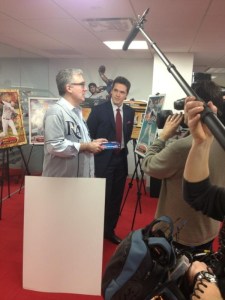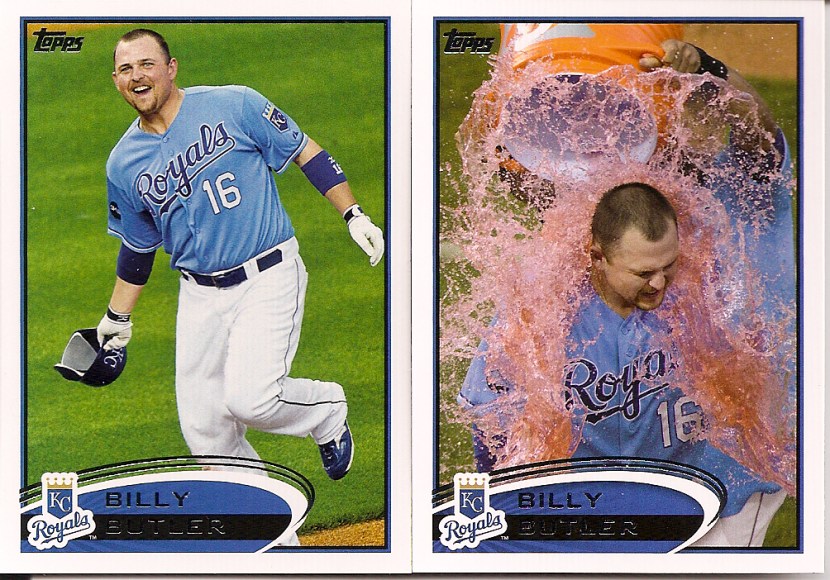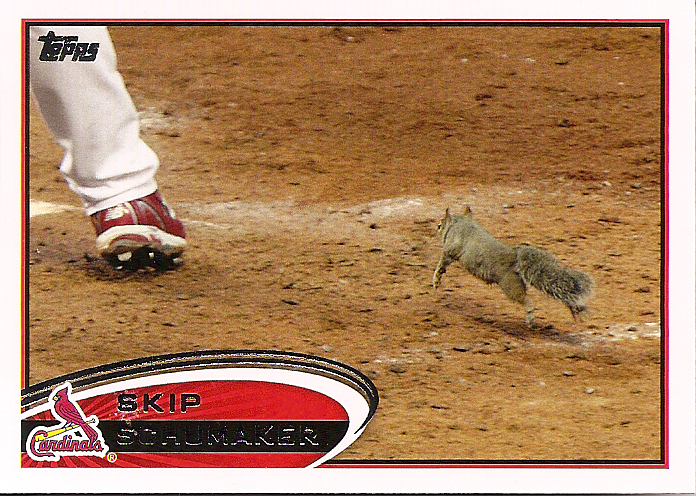Tagged: Jose Reyes
The Marlins: A Modest Proposal
So. Time to take Marlins Park and: A) Disassemble it; B) Crate it; C) Sell It; D) Ship it to San Jose (or Oakland, or Portland, or San Bernardino, Austin/San Antonio/Round Rock, or – wherever).
Now that the Miami experiment is over (as forecast here a year ago next week, and reiterated here last June) and Hanley Ramirez, Heath Bell, Jose Reyes, Mark Buehrle, Josh Johnson, and the merely arbitration-eligible Emilio Bonifacio have either been offloaded in A Going-Out-Of-Business-Sale (or are about to be), the Marlins are officially the Montreal Expos of the 2010’s and baseball is unofficially dead in Florida.
Notice I did not write South Florida. All of it. Rays’ owner Stu Sternberg was already less than sanguine about getting significant scratch from the state and local governments for a new ballpark that is absolutely essential to his survival in Tampa/St. Petersburg. If he had any hopes left after the disastrously low crowds for the free ballpark the good burghers of Florida gave Jeffrey Loria, they have to be gone now and he has to be looking elsewhere.
There are all sorts of other implications if the Reyes/Buehrle/Johnson deal to Toronto is completed as advertised. Obviously, this revivifies a Toronto franchise that was already showing signs of being on the upswing last year and as far back as 2010-11. It sure knocks the price down for whoever is the Jays’ first choice for the manager’s job. It might make John Farrell a little remorseful. And it buries the Yankees in the American League East; there would now be at least three other teams in the division with more talent than New York. The prospects of Alex Rodriguez going to the lame duck Miami franchise (first reported blah blah blah here and blah blah blah ) might actually have increased, on the premise that Loria and MLB have to do something to make it at least look like they’re trying to field a product worthy of 2013 big league ticket prices).
But the biggest long-term implications are fairly simple: the franchise carousel, all but quiet since the upheaval of the 1953-72 era, will begin to spin again.
Miami has a slight chance of survival (that stadium is standing, and a mess of prospects can suddenly win a division – ask the Oakland A’s about that) but Tampa Bay is gone. One would assume that at the latest the season of 2020 opens without a Florida team in the majors.
Where do the Rays (and probably the Marlins) move?
Here are the top U.S. Metropolitan Areas without MLB teams ranked by population, on 2011 estimates drawn from the Official 2010 United States Census:
12. Riverside/San Bernardino/Ontario CA 4,304,997
23. Portland OR/Vancouver WA 2,262,605
24. San Antonio/New Braunfels TX 2,194,927
25. Sacramento/Roseville CA 2,176,235
26. Orlando/Daytona Beach FL 2,171,360
30. Las Vegas 1,969,975
31. San Jose 1,865,450
32. Columbus OH 1,858,464
33. Charlotte/Gastonia NC 1,795,472
34. Austin/Round Rock TX 1,783,519
35. Indianapolis 1,778,568
36. Virginia Beach/Norfolk 1,679,894
37. Nashville 1,617,142
Nashville you say? Virginia Beach? Hahahahahahaha?
Not so fast. Every metropolitan area on this list is larger than Milwaukee and Riverside, Portland, San Antonio and Sacramento are bigger than Cincinnati. There are certain practacalities here. All of Southern California is Dodger/Angel territory and the Magic Johnson group that just spent Eleventy Billion on the Dodgers isn’t going to give up claim on anything. Though Texas is a big place don’t tell that to the Rangers and Astros, who claim both the San Antonio and Austin zones. Columbus is Cleveland’s territory (unless it’s Cincinnati’s), Orlando would have at least some of the same problems as Tampa/St. Pete, and the Giants and Athletics are in their fifth different decade of arguing over San Jose.
So the Rays go to Portland and the Marlins to Sacramento? Not so fast.
You know who’d be 15th on the list – right between Phoenix and Seattle – if we made it of not American metropolitan areas but North American?
Right.
15. Montreal, Quebec, Canada. Regional population: 3,824,221.
But wait, didn’t things go very badly in Montreal before? They certainly did, but not because of the city nor its love of baseball. Corrupt government and underfunded ownership and a betrayed fan base – all of them saddled with the greatest white elephant in the history of North American sports construction, Olympic Stadium. In every full season between 1979 and 1983 – even in that XXL Airplane Hangar – Les Expos drew at least 2,102,173 fans a year.
The peak total – 2,320,651 in 1983 – edged out the Cardinals for second place in National League attendance, and was just about a million more than the Mets drew in New York. It was about then that stuff started falling from the roof of the tribute to provincial graft, and star players started falling off the Expos’ roster. But make no mistake about it: Montreal supported baseball. As late as 1997 the Expos still brought in a million-and-a-half fans (more than the Mets or the Giants).
If all that could not be done in the ’90s and ’00s could be put together – a downtown stadium with government support, plus a well-run franchise making a long-term commitment – baseball’s second try in Montreal could be a triumph. And consider if it were the Rays fleeing north. Not only would Montreal get that well-run franchise, but it would suddenly find itself in a division with rivals from hated cities like Boston and New York…
…and Toronto.
Montreal and Toronto in the same division. Genius, I tells ya. Genius.
It’s a win-win. Unless you’re one of those few Florida baseball fans.
Oh yeah, I left out a fifth thing to do about the Marlins and Marlins Park: E) Ship Giancarlo Stanton separately. And while you’re at it, you might as well start wrapping uber-prospect Christian Yelich too.
10th Annual Topps Pack Opening Day
For years, as part of my moonlighting as an unpaid consultant for Topps Baseball Cards, I have engaged in a ritual involving a few company executives and a few (brand new) boxes of that year’s Topps set. The first box to come off the production line is ceremonially opened, either on television or at Topps HQ, and then we quietly pillage through whatever’s available pack-wise.
Today we turned it into a happening.
This started when I ran into my colleague and fellow collector Greg Amsinger at MLB Network two weeks ago. Greg is giddy enough about cards that I once almost distracted him from a Yankee Stadium live shot by advising him that my collection included three Honus Wagners. When the Topps gang and I set the “ripping of the first packs” for today, I asked if I could invite Greg along.
Ka-boom.
Greg brought a camera crew, Topps put up a display including blowups of the cards of Pujols and Reyes in their new unis and the one-of-a-kind gold card inserts, they assembled the entire 2012 Baseball Production team, I dressed up in my Matt Moore First Win Game-Used uniform, they fitted up a conference room full of unopened boxes, and pizza, and I had to give a little speech, and half of the staff snapped photos on their phones and their tweets out even before I finished talking (insert your own joke here; I actually had to be brief for a change as I’m still under doctor’s orders to not try to ‘project’ with some severely strained vocal cords and throat muscles).
Suddenly we went from four guys sitting in a room going “nice shot of Braun” to a veritable orgy of pack opening. It felt like snack time at Willy Wonka’s Chocolate Factory and I must say, for something that was made ‘bigger’ than in years past at least in part to utilize the presence of a tv camera, this organically and spontaneously turned into a really fun ninety minutes in which the pride of the employees – to say nothing of the imminent promise of spring and another MLB season – were in full bloom.
Before we get inside the packs, and a really exceptional effort by Topps this year (to say nothing of a sneak peek at their next issue, 2012 Heritage) a couple of fun images.
The Topps production team all signed the first box that was part of the ceremonial presentation depicted above. They do it at aircraft factories and they do it on the first production runs at Apple – so why not? And on the right is that display I referenced complete with the Pujols and Reyes blow-ups. I have no idea how poor Amsinger, Cardinal diehard that he is, got past this graphic testament to the fact that Albert has surrendered his legacy in St. Louis and is now tempting the curse of Almost Every Angel Free Agent Contract Ever (Amsinger, when I pulled a Mark Trumbo card today: “It should say third base on his card. Where else is he going to play for them?” Me: “First. After you-know-what happens.” Amsinger: shakes head dolefully).
Over the last few years, Topps has been steadily improving the photo quality of their base set, but this year a great leap has been made. The photos are better sized and framed, more interesting, more innovative, and with the ever-increasing improvements in the mechanics of photography, crisper and more compelling. The embossing makes the names difficult to scan but the shots here of David Robertson and Jose Altuve are really terrific and virtually every square quarter-inch of the card frame is filled and filled cleanly. There’s a design decision here, visible in the Altuve card, to sacrifice the tip of his left foot to minimize dead space – and I think it works wonderfully.
And then come the fun cards. There are SP’s (single prints, if you’re not a collector – cards that you know going in are much scarcer than the regular 330 cards) that include Reyes and Pujols sent by the magic of computers into their new uniforms. When you consider that as late as 1990 Topps was still airbrushing the caps of traded players – literally hand-painting logos over the original one, not on a photograph, but on a negative measuring 2-1/2 x 3-1/2 inches) – let’s give the computer a round of applause.
computers into their new uniforms. When you consider that as late as 1990 Topps was still airbrushing the caps of traded players – literally hand-painting logos over the original one, not on a photograph, but on a negative measuring 2-1/2 x 3-1/2 inches) – let’s give the computer a round of applause.
The flatfootedness in the Reyes card makes it a little clunky but it gives you a pre-Spring Training hint at how the new Miami uniforms are going to visually ‘feel’ once the rechristened club takes the field.
Two years ago the theme of the SP’s were the Pie-In-The-Face celebrations, mostly enacted by the Yankees’ A.J. Burnett. This year the premise is celebrations and mascots, and in the case of the former, particularly the Gatorade Bath:
Butler, caught just as the orange goop explodes but before he’s lost under it, is a classic card. But, to my mind, the SP version of Mike Morse’s card 165 and its suspension-of-the-wave is an instant All-Time Great:
But 48 hours after the cards reached dealers and collectors, most of the publicity has surrounded the short print of #93 Skip Schumaker.
The Cardinals’ second baseman is said to be ticked off – and I happened to see Kevin Millar, serious for the first time in months, take unnecessary umbrage at the St. Louis Rally Squirrel squeezing Schumaker  out of frame – but remember, for every one of those cards, there are several hundred of the regular one on the right here. Happy? Nice boring five-cent card compared to one that’s rather crazily being bid up to more than $200 on eBay?
out of frame – but remember, for every one of those cards, there are several hundred of the regular one on the right here. Happy? Nice boring five-cent card compared to one that’s rather crazily being bid up to more than $200 on eBay?
Players take the baseball card photo a lot more seriously than they would have you believe. Several inscribe cards bearing particularly unflattering pictures with notations about how much they hate the photo. On occasion players won’t even sign their cards based solely on the choice of image.
The real trick for the Schumaker SP 93 will be not to get the player to sign it – he’s noted for a good heart, I’m sure the charity possibilities will be raised to him and he’ll sign a bunch. The problem is going to be getting that Squirrel to sign the card. Incidentally, the squirrel isn’t a Topps first; a card of “Paulie Walnuts,” a squirrel who occupied a foul pole at Yankee Stadium, was issued in 2007.
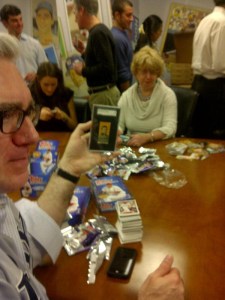
 I promised a preview of Topps Heritage 2012 and that’s coming – but one more aside first. I thought I’d pay off the day I scared Greg Amsinger with my Wagner boastfulness by bringing the famed T206 scarcity to Topps to link up the past and the present. He didn’t know it was coming, which is why he’s been caught mid facepalm on the right.
I promised a preview of Topps Heritage 2012 and that’s coming – but one more aside first. I thought I’d pay off the day I scared Greg Amsinger with my Wagner boastfulness by bringing the famed T206 scarcity to Topps to link up the past and the present. He didn’t know it was coming, which is why he’s been caught mid facepalm on the right.
And lastly, Heritage. They’ve done another meticulous job matching up the set celebrating its 50th anniversary, the vibrant 1963 design, in which the glowing colors of ’60s Topps were first evident: 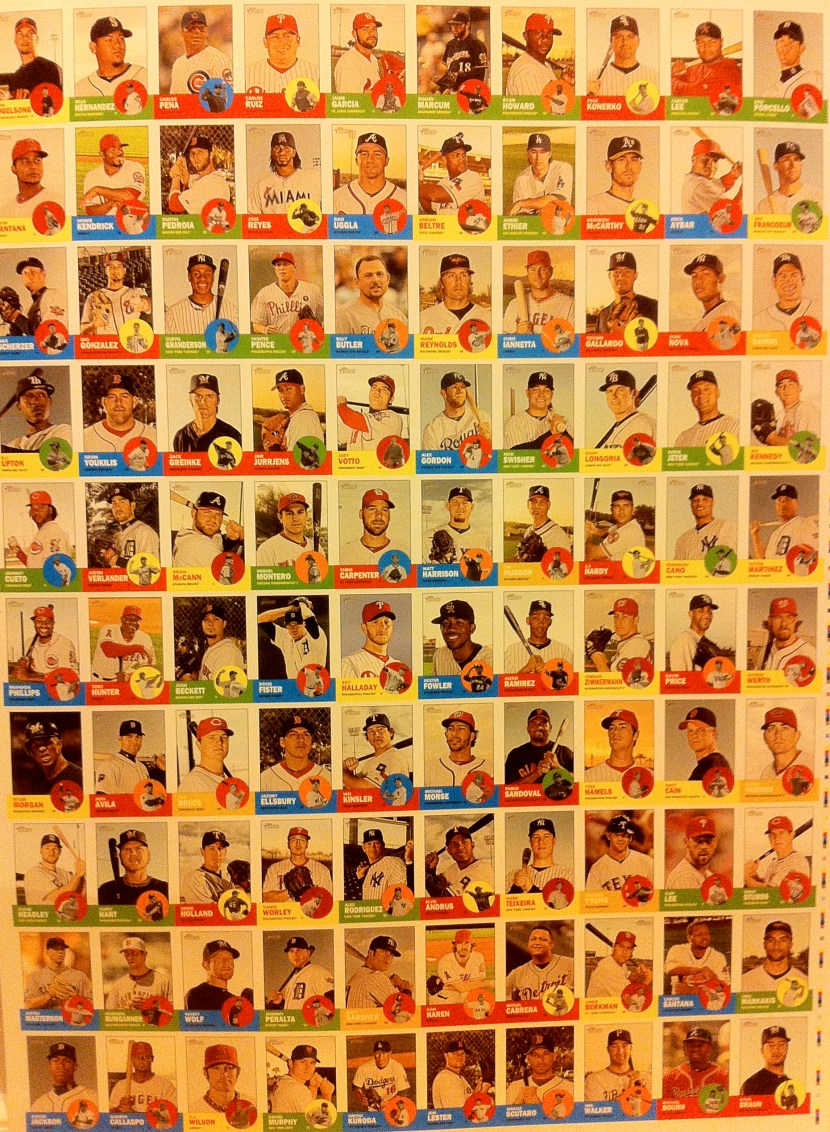 A lot of star players on this sheet – and forgive the waviness of the photo: it’s a sheet.
A lot of star players on this sheet – and forgive the waviness of the photo: it’s a sheet.
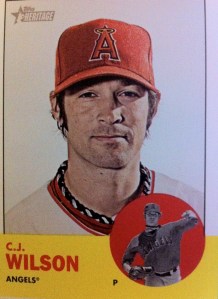
 Two cards in particular jumped out at me: Reyes again in what looks like a photo actually shot at the news conference announcing his move to Miami (although that could easily be a little misdirection) and C.J. Wilson in Angel garb.
Two cards in particular jumped out at me: Reyes again in what looks like a photo actually shot at the news conference announcing his move to Miami (although that could easily be a little misdirection) and C.J. Wilson in Angel garb.
One note on deadlines: Chris Iannetta is shown with the Rockies in the Topps set, but has already been updated to his new Angels’ uniform in the Heritage issue.
Miami In A Vice
They have gone out and spent the money on what looks like a fabulous and distinctive new ballpark.
They have gone out and spent the money on what is an often fabulous and always distinctive new manager.
They are evidently willing to go out and spend the money (“in the range of five years, $18-$20 million a year,” per Buster Olney on ESPN) on Jose Reyes and might be able to snare Albert Pujols as well.
They even went out and spent the money on rebranding themselves as a city, not a state, and on some decent looking new uniforms (although the basic premise of the attire struck me as an adaptation of the original 1977 Toronto Blue Jays’ unis, with orange substituted for powder blue).
And I think it will all end in disaster.
As the 20th season of Marlins baseball looms, there is still almost no evidence that South Florida is a major league baseball community, or that it wants or needs big league ball. The entire dynamic could be changed by the new roofed stadium, but the certitude about that – and the willingness to wager literally hundreds of millions of dollars on that certitude – is, to me, unjustified. With the caveat that I know from sopping-wet experience that Joe Robbie/ProPlayer/Whatever Stadium was a miserable place to watch a ballgame, I still think that it’s mortifying that the Fish averaged 37,838 fans per game in their inaugural season of 1993, and 33,695 in 1994 – and never came close to that figure again.
I mean, not close. The World Champions of 1997 played before an average house of 29,190. Otherwise they have had just five seasons of more than 19,007 paid admissions per game, and four that were below 15,766 a year.
Team president David Samson thinks some improvement on the squad and the ballpark will convert a city that has for two decades been saying ‘you fill me with inertia’ will suddenly convert into producing “30 to 35,000 every single game.”
This was a city that could not support AAA baseball in the ’50s, and never again tried higher than A-ball. And I don’t buy the idea that a high-priced indoor facility in Miami proper rather than it a remarkably hard-to-get-to corner of Fort Lauderdale is now going to entice 37,000 fans away from everything else the city offers, especially at night. Pujols and Reyes would be hard to resist. Then again the Marlins fans of nine seasons ago resisted the 2003 World Champions (except for 16,290 of them each game). I’m not even sure how a $95,000,000 investment in Reyes and lord knows how much in Pujols would translate into profitability or even break-even status.
Reyes alone will not do it – ask the Mets.
As if these doubts were not enough, late last night the impeccable Clark Spencer of The Miami Herald tweeted something to make Miami fans shiver:
Source: H. Ramirez is not at all pleased at prospect of changing positions if
#Marlins sign Reyes; the two aren’t the friends many portray.
When the Reyes rumors first started, Spencer had quoted Hanley Ramirez with words that bring honor to the role of wet blanket: “I’m the shortstop right now and I consider myself a shortstop.”
One can easily see where all this will go if a) Ramirez and Reyes squabble; b) Reyes gets hurts again; c) the Marlins don’t sign enough new talent to compete in a daunting division; d) the fans don’t show up; or e) all of the above, in any order you choose. When the ’97 Marlin World Champs did not yield a new stadium, 17 of the 25 men on the World Series roster were gone by mid-season 1998 and three more by mid-season 1999.
Imagine Jose Reyes being traded in a fire sale in the middle of 2013. Or Albert Pujols.
SPEAKING OF ALBERT…
A quick thought about the new Cardinals’ manager.
I met Mike Matheny during the nightmarish 2000 NLCS when Rick Ankiel was hit by the same psychological trauma – damage to a close male relative or friend who had taught him the game – that befell Steve Blass, Chuck Knoblauch, Steve Sax, the ex-pitcher-turned-author Pat Jordan, and others. Matheny had cut up his hand opening the odd gift of a really big hunting knife, and had to turn over Cardinals’ catching to Carlos Hernandez.
Matheny was devastated, but less for himself and far more for what his absence meant to Ankiel. I don’t know that this has been reported since the time Ankiel’s problems crested (I know I put it on our Fox broadcasts of the Cards-Mets playoffs), but Matheny told me that several times during the season Ankiel had begun to spiral out of control the way he did in that heart-stopping start against New York. “But I could calm him down, I was able to stop him. Last night, watching it, I felt helpless. Worse, I felt paralyzed. I could’ve talked him out of it.”
Consider this in the later context. Ankiel was collapsing under the weight of his father – who had driven him throughout his youth and into his career – going to prison for drug-running. The problem would run Ankiel out of the majors the next year and make him an outfielder two years after that. Yet Matheny was somehow able to encourage him, reassure him, or simply bullspit him, into overcoming this set of complex psychological phenomena.
Put that into a skill set that includes good game judgement, an ability to easily relate to everybody from batboys to announcers who wouldn’t give anybody a hunter’s knife as a present in a million years, and all the other non-healing powers a manager is supposed to have, and I think it’s safe to infer Matheny will be a pretty good big league skipper.
False Spring In New York
Pitchers and Catchers report, New York temperatures clear 40 degrees, and somebody issues a forecast that references “55” by the end of the week and it’s not the age of the latest pitcher the Yankees invited to camp.
sses Young and Capuano, and the likelihood that R.A. Dickey actually found himself last season at the age of 35). And the bullpen? You don’t want to know about the bullpen.
What Price Jeter?
Let’s put aside for a second the premise that Derek Jeter believes he should be baseball’s second-highest paid player after a season in which he batted .241 against right handed pitchers. Let’s not address what it must look like in that higher plane of consciousness in which a team should pay a man $25 million a year through his 42nd birthday not because he is performing at that a supreme level of production, but out of loyalty and recognition of past greatness, and because he deserves to make nearly as much as Alex Rodriguez does.
Expectations And More Minor Leaguers
My apologies for my negligence here of late. It’s been busy.
Reyes And Ruth And (T.) Rex
Fascinating to watch Jose Reyes, out nearly a year, so rusty and nervous that he stutter-stepped towards a grounder early in the Mets-Nats game Saturday afternoon, and barely made it in time to the bag on a 2-4 doubleplay. Yet by the 8th inning he was barehanding a grounder, and in the 9th, leading an abortive rally on an otherwise frustrating day for the Queens faithful.
A Whole Lotta Lobster
Too much shellfish, you say?
Oy Vey, Oy Vey Oy Vey Jose
Jose Reyes’ injury is a hamstring tear????
No confirmation on this elsewise but Mr. Burkhardt knows his stuff.
UPDATE 9:04 EDT: Now confirmed by a Mets’ statement, via the Associated Press, with the timeline hazy: “(An) MRI revealed a small tear in his right hamstring tendon, a new injury. Reyes will rest for two days and then resume treatment.”
